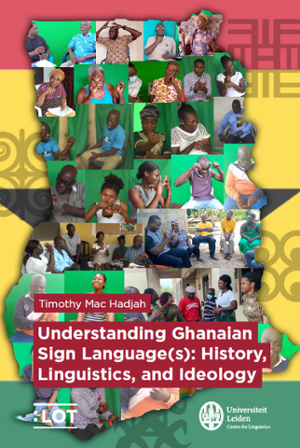Dissertation
Understanding Ghanaian sign language(s): history, linguistics, and ideology
On the 27th of June, Timothy Mac Hadjah successfully defended a doctoral thesis. Leiden University Centre for Linguistics congratulates Timothy on this achievement!
- Author
- Timothy Mac Hadjah
- Date
- 27 June 2024
- Links
- Leiden University Repository

The thesis explores Ghanaian Sign Language (GSL), the national sign language of Ghana within urban deaf communities. Using historical, linguistic and ideological data, the research discovered GSL is a cover term for various signing forms (e.g., ENGLISH, BROKEN, LOCAL). Tracing GSL roots back to the introduction of American Sign Language (ASL) in 1957 by an American missionary, this research unveils a lasting connection between ASL signs and GSL.
The thesis presents GSL's historical journey amidst significant challenges such as discrimination and sign language bans (oralism). It sheds light on signers' resilience and contributions to GSL's evolution. This exploration also highlights the emergence of local signing varieties (e.g., school-lects) alongside foreign-based signing forms within a triglossic framework that resembles the distribution and use of spoken languages in Ghana and other African countries.
The thesis unearths lexical relationships, examining variants of GSL’s connections not only with ASL but also with locally evolved village sign languages like Adamorobe SL and Nanabin SL. Moreover, the study investigates the expression of Size and Shape Specifiers (SASS) within GSL and Ghanaian gestural communication, offering valuable insights into the susceptibility of sign languages to their gestural environment throughout their life spans.
Beyond linguistics, the book explores social landscapes and language ideologies of sign languages in the Ghanaian urban deaf communities. It reveals a pluridimensional continuum of GSL usage and the interplay between high- and low-prestige variants. As an invaluable resource, this thesis enhances the understanding of African national sign languages, providing essential insights for researchers, teachers, and learners.
